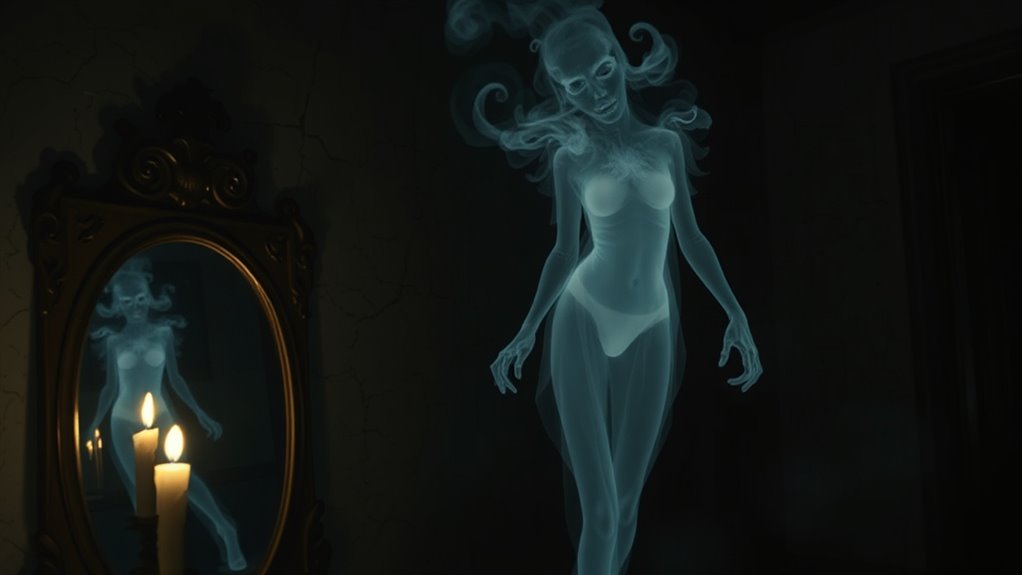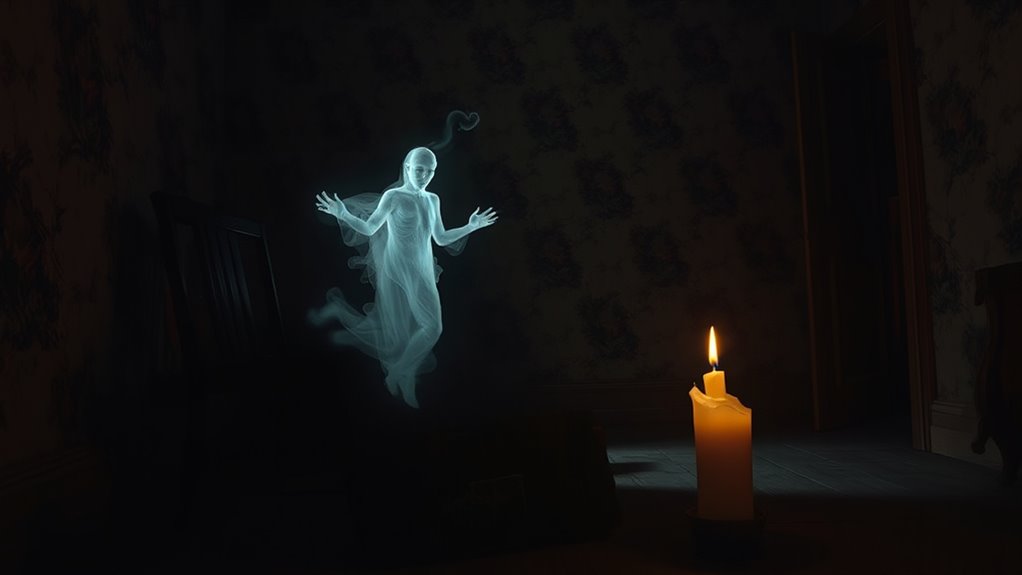Ghosts can’t physically harm you, according to scientific evidence that labels them as energy forms linked to emotional attachments. However, many people report feelings of vulnerability and experiences of unexplained scratches or bruises after ghost encounters. These sensations often stem from psychological factors, stress, and cultural beliefs surrounding the supernatural. Understanding these dynamics can offer peace of mind, leading to effective healing techniques and insights. Discover how you can manage these experiences further.
Key Takeaways
- Scientific evidence does not support the physical existence of ghosts or their ability to cause harm.
- Psychological factors, such as stress and anxiety, can create sensations attributed to ghostly encounters.
- Many reported physical experiences, like scratches or bruises, may stem from psychological symptoms rather than supernatural forces.
- Cultural beliefs often amplify fears of ghost-related harm, interpreting normal events as supernatural attacks.
- Spirit release techniques can help alleviate emotional turmoil related to ghostly encounters, promoting healing and reducing anxiety.
Understanding Ghosts and Their Nature

Although many people find the idea of ghosts intriguing, understanding their nature can be complex. You might hear ghost stories that describe apparitions, poltergeists, and spirits, each with unique traits shaped by cultural beliefs.
Many cultures recognize ghosts as energy forms that linger due to unfinished business or emotional attachments. However, despite the numerous accounts, scientific evidence generally denies their physical existence, labeling ghost hunting as pseudoscience.
Around 18% of Americans have reported seeing a ghost, stemming from ancient practices like animism and ancestor worship. While these encounters can be compelling, it’s essential to approach them with skepticism, as they often lack empirical backing.
Ultimately, ghosts may influence the living, but the risk of physical harm remains unfounded.
Psychological Perspectives on Ghostly Encounters

When you think about ghostly encounters, it’s fascinating how much your mind shapes those experiences.
Psychological symptoms can manifest in ways that feel real, leading to physical sensations or wounds. Understanding this connection can be essential for healing and releasing any harmful beliefs tied to spirits.
Mind’s Influence on Experiences
The mind plays an essential role in shaping your experiences with the supernatural, as psychological factors can heavily influence how you perceive ghostly encounters. Your emotional state can amplify sensations, leading to the mind’s influence creating physical manifestations like scratches or bruises that you may attribute to paranormal activity.
Parapsychologists suggest that events often labeled as poltergeist activity might actually stem from intense emotional responses rather than true supernatural forces. Stress and anxiety, common psychological conditions, can distort your perception, making ghostly encounters feel more real and threatening.
Recognizing these dynamics is vital; understanding them can lead to effective interventions like counseling, helping you address the fears and anxieties tied to these experiences.
Psychological Symptoms and Manifestations
As you navigate the domain of ghostly encounters, it’s important to recognize how psychological symptoms can manifest in response to fear and anxiety. Often, the mind’s influence leads you to interpret physical sensations—like scratches or bruises—as results of supernatural forces.
Parapsychologists argue these manifestations are rarely due to actual ghosts; instead, they reflect your mental state. Reports of ghost-related injuries often find their roots in emotional distress, echoing phenomena similar to stigmata.
In these cases, addressing underlying psychological issues can provide more clarity than attributing harm to spirits. Understanding how psychological symptoms play a role in your experiences with ghostly encounters can pave the way for effective solutions, helping you manage anxiety and distress linked to these perceived interactions.
Spirit Release and Healing
Psychological perspectives on ghostly encounters shed light on how spirit release techniques can facilitate healing for those experiencing emotional turmoil.
Engaging in spirit release can markedly improve your emotional well-being by addressing the negative impacts of lingering spirits. Here are three ways this therapy helps:
- Reducing Anxiety: Spirit release alleviates mental tensions, leading to lower anxiety levels.
- Promoting Peace of Mind: By helping trapped spirits move into the light, you can find relief from emotional burdens.
- Healing Past Trauma: Understanding and resolving unresolved issues can break the cycle of fear, fostering a healthier mental state.
Ultimately, spirit release isn’t just about the spirits; it’s also about restoring balance in your life and enhancing your overall emotional health.
The Role of Parapsychology in Ghost Phenomena

When you consider ghostly experiences, it’s essential to acknowledge the mind’s powerful role in shaping those encounters.
Parapsychology offers psychological explanations for physical harm associated with these phenomena, suggesting that much of what you perceive may stem from your own subconscious.
Mind’s Influence on Experiences
While many people attribute ghostly experiences to supernatural forces, parapsychologists argue that these phenomena often stem from the subconscious mind.
The mind’s influence can shape how you perceive and react to these events, leading to sensations that feel real but may not have physical origins.
Here are three key points to evaluate:
- Subconscious Reactions: Your brain may interpret stress or anxiety as ghostly encounters, creating a cycle of fear.
- Physical Symptoms: Rarely reported scratches or bites should be evaluated critically, as they mightn’t stem from a paranormal source.
- Psychological Interventions: Understanding these influences can help you find effective coping strategies, addressing anxiety and emotional distress related to hauntings.
Psychological Explanations for Harm
Understanding the mind’s role in ghost phenomena can reveal surprising insights into reports of physical harm.
Parapsychologists argue that poltergeist activity, often linked to physical injuries, may actually arise from your subconscious rather than supernatural forces. While you might encounter rare instances of scratches or bites, it’s important to explore natural explanations first.
Your brain interprets ghostly experiences, and psychological explanations play a vital role in understanding these manifestations. For instance, the similarities between stigmata and alleged ghost-related injuries suggest that psychological factors can create physical marks.
Addressing Paranormal Phenomena Psychologically
As you explore the domain of ghost phenomena, it’s vital to recognize how parapsychology offers valuable insights into these experiences. Understanding the psychological dynamics can help you navigate claims of hauntings.
Here are three key points to reflect upon:
- Subconscious Influence: Poltergeist activity often stems from the subconscious mind, reflecting unresolved emotional issues rather than actual ghostly entities.
- Natural Explanations: Before attributing physical symptoms to the paranormal, it’s essential to rule out psychological factors and natural causes linked to mental states.
- Intervention Potential: Psychological interventions can effectively address distressing experiences, suggesting that many ghostly encounters are shaped by your emotional and mental state.
Recognizing these elements can transform your understanding of paranormal claims and help you respond more effectively.
Cultural Beliefs and Their Impact on Perceptions of Harm

Cultural beliefs shape how you perceive harm from ghosts, creating a lens through which unexplained injuries and emotional distress are often attributed to supernatural forces.
In many societies, ghostly harm is linked to narratives of vengeful spirits seeking retribution for unresolved issues. When you believe in ghosts, everyday occurrences may appear threatening, amplifying anxiety and interpreting normal events as supernatural attacks.
Rituals designed to appease or banish spirits reflect cultural practices aimed at reducing perceived ghostly harm, influencing community responses to hauntings.
Ghost stories and folklore play a significant role in reinforcing these fears, with tales passed down through generations, shaping collective beliefs about the dangers that spirits may pose.
Understanding these cultural contexts can clarify your own perceptions of paranormal threats.
Healing and Spirit Release Techniques

Many people find healing and spirit release techniques effective for addressing the emotional and physical harm caused by lingering spirits.
These methods help individuals move trapped spirits into the light, promoting well-being. Here are three techniques you can explore:
- Visualization: Picture a bright light enveloping the spirit, guiding it toward peace.
- Meditation: Engage in focused meditation to connect with your inner self, fostering emotional clarity and healing.
- Cleansing Rituals: Use sage or salt to cleanse your space, creating an environment that encourages spirit release.
Personal Experiences and Community Insights

While some people dismiss ghostly encounters as mere imagination, countless individuals share compelling stories of experiences that left them feeling physically harmed. Many report scratches, bruises, or even unexplained illnesses after their encounters.
Community discussions often highlight how psychological factors, like fear and belief, can amplify these sensations, making you feel more vulnerable. You might find that some attribute their perceived ghost attacks to unresolved emotional issues or negative energy, suggesting they feel targeted by spirits.
Reports vary widely—some recall minor disturbances, while others endure significant emotional distress or physical injuries. Cultural narratives and personal beliefs shape how you interpret and react to these phenomena, influencing your perception of potential physical harm.
Frequently Asked Questions
What Can Ghosts Do to You?
Ghosts can evoke a range of experiences for you, from feelings of unease to unexplained noises. You might sense a presence or even see shadows moving.
Some report physical manifestations like cold spots or sudden chills. While many believe these encounters are harmless, they can lead to emotional distress, causing anxiety or fear.
Ultimately, the impact of a ghostly encounter often depends on your beliefs and mental state, shaping how you perceive these experiences.
What Is a Ghost Attack?
A ghost attack typically refers to experiences where you feel physical or emotional harm from a supernatural entity.
You might encounter unexplained scratches, bruises, or intense feelings of distress that you attribute to a ghost. These incidents vary, with some being benign while others leave you shaken.
Your beliefs and emotions can heavily influence how you interpret these experiences, often shaped by cultural narratives and personal sensitivities to the unknown.
Can a Ghost Physically Touch You?
Imagine a chill creeping up your spine as you feel a faint brush against your skin, yet no one’s there.
You wonder if a ghost can physically touch you. Many believe these sensations stem from your mind, influenced by emotions like fear or stress.
While some claim to feel ghostly contact, scientific explanations often point to psychological factors rather than any supernatural force.
Can Ghost Hurt Normal?
When you think about whether ghosts can hurt normal, it’s essential to contemplate how fear and anxiety can influence your perception.
Often, people interpret minor injuries or sensations as ghost-related, especially during emotional distress.
While there are reports of physical encounters, these are typically rare and can often be explained by psychological factors.
Conclusion
So, can ghosts really harm you? Well, unless you count tripping over your own feet in a dark room as a spectral attack, you’re probably safe. Sure, they might give you a chill or an eerie feeling, but it’s likely just your imagination running wild after that horror movie binge. Embrace the mystery, laugh at the shadows, and remember: the only thing to fear is your own Wi-Fi dropping during a ghost-hunting livestream!









